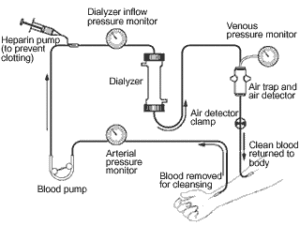
Kidneys act as a filter for blood in the body. When a patient has chronic renal failure, they must either receive dialysis or undergo a kidney transplant. Dialysis is likely to be recommended when waiting to receive a transplant. Dialysis primarily functions as an artificial kidney, working to filter harmful wastes, salt, and excess fluid from your blood.
What is it?
When a patient is suffering from chronic renal failure, his or her only option is to receive kidney dialysis treatment until a donor organ is found for a kidney transplant. Kidney dialysis can be a life-prolonging treatment for years, but the risks and complications often lower quality of life. Since the patient’s kidney is nonfunctional, a new method to filter the blood of waste and excess fluid is needed, and dialysis provides that function. Two types of kidney dialysis exist with different methods of filtering the blood: hemodialysis and peritoneal dialysis. During hemodialysis, a dialysis machine filters the blood. During peritoneal dialysis, the abdomen is filled with a solution that helps cleanse the blood within the body. The lining of the stomach acts as a natural filter through which wastes are removed using the cleaning solution, dialysate. The two different types of kidney dialysis are both effective treatments, and the decision to choose one should be made with the consultation of the patient’s doctors.
What should I do to prepare?
After undergoing an extensive medical examination, patients will require a vascular access to be made weeks prior to the kidney dialysis (hemodialysis) procedure. This vascular access may use an AV fistula or an AV graft depending on how large the patient’s arteries and veins are. The vascular access must be given time to heal before dialysis treatments begin so it should be created months before the first dialysis treatment. Peritoneal dialysis will similarly require a catheter to be surgically placed before treatments begin, also allowing for a significant amount of time for it to heal.
What happens during the process?
During hemodialysis, the patient will be hooked up to the machine that replaces the function of the kidney by filtering the blood. After a vascular access is created and fully healed, the dialysis sessions may begin. Blood from the patient flows through the vascular access and into the dialysis machine where a special filter is in place to remove the waste and fluid. The blood is then transported back into the body through the machines’ tubes. During peritoneal dialysis, the patient will have a plastic tube or catheter placed into the abdomen by the surgeon. The dialysate or the cleansing solution is fed into the abdomen through the catheter in cycles, and the blood is filtered. The fluid is removed from the body using the same catheter.
Dialysis sessions occur many times a week and the length of time each session takes depends on the state of the patient’s kidneys and other individual factors such as the patient’s weight.
What are the risks and potential complications?
Because dialysis is only performed when a patient is suffering from serious chronic renal failure, these patients will likely have other health problems. Dialysis treatments may result in:
- Muscle cramps
- Irregular sleep patterns
- Itchy skin
- Anemia
- Low blood pressure
- High blood pressure
- Depression
- High potassium levels
- Fluid overload
- Stiff joints
Disclaimer:
All GlobeHealer Site content, including graphics, images, logos, and text, among other materials on the site are for educational purposes only. This content is not intended to be a substitute for professional medical advice, and you should always contact your physician or qualified health provider for information regarding your health. Information on this site regarding the overview, diagnosis, and treatment of any kind should be looked at, in addition to the advice and information of your health care professional. Do not disregard medical advice or delay seeking treatment or medical advice due to information found on the GlobeHealer site. If there is even the possibility that you may have a medical emergency, seek treatment, call your doctor, or call your local emergency telephone number immediately. GlobeHealer does not endorse being the first line of communication in case of emergency and does not endorse any specific test, physician, facility, product, procedure, opinion, or other information that is or may be mentioned on this site or affiliated entities. Reliance of any and all information provided by GlobeHealer, its employees, affiliations, others appearing on the Site under the invitation of GlobeHealer, or visitors of the site is solely at your own risk and is not the responsibility of GlobeHealer.
Image Source: https://upload.wikimedia.org/wikipedia/commons/7/75/Hemodialysis_schematic.gif
